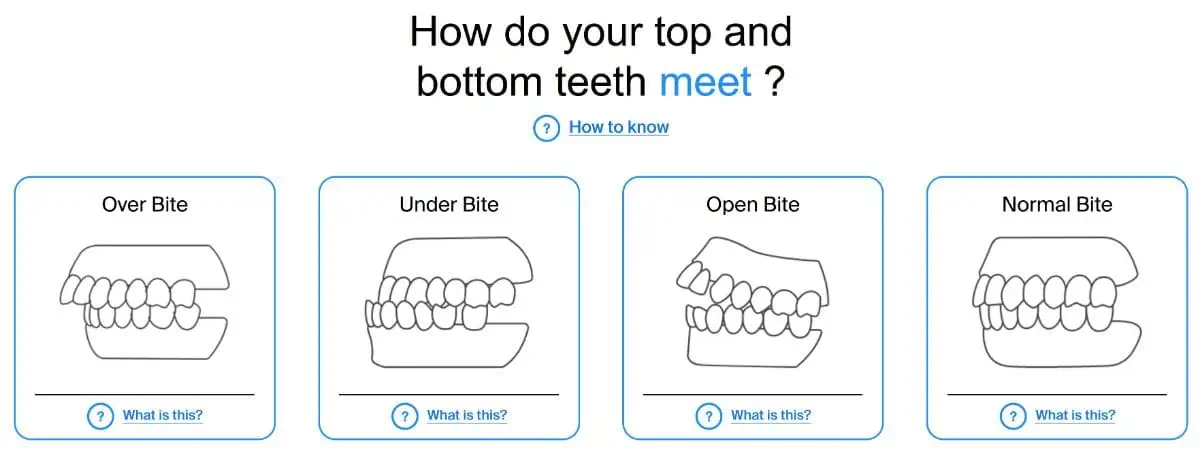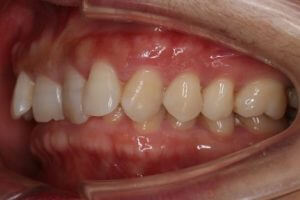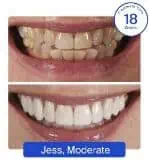Two of the most important questions for anyone considering Invisalign clear aligner treatment are: How long does Invisalign take and how much will it cost?
We have Invisalign costs covered on a separate page, so here we're going to look at how long Invisalign takes to straighten teeth.
Invisalign is the a popular brand of clear aligner in the UK, effective on around 90% of orthodontic cases including:
- Crooked teeth
- Overcrowding
- Gaps in teeth
- Crossbite, overbite and underbite
If you haven't already verified that you are a good candidate for Invisalign treatment, you can check using their free online Smile Assessment. Then, keep reading to learn more about what might affect your own Invisalign treatment timeframe.
The short answer is: It depends! Complex cases may take 18 months or more to correct, whereas moderate cases may only require 3 to 6 months. The duration of the treatment is determined by a number of factors, which we will discuss in this article.
If you're considering Invisalign treatment, we recommend also having a look at the more affordable alternative, Smile White! Like with Invisalign, they can treat more complex cases. Plus, you'll get free whitening and retainers worth £790.
Click the button below to book a FREE e-consultation, or read our Smile White Review for more information.
Use “DENTALY5OFF” to save an additional 5% on your treatment.
[/featured_box]
In This Article
How long does Invisalign take to work?

Many Invisalign patients notice their teeth moving within just a few weeks of starting treatment. One of the benefits of wearing clear aligners is that you can begin to enjoy your straighter-looking teeth while your treatment is still in progress.
Aligner treatment consists of a series of clear aligners, each pair typically worn for 10-14 days before changing to the next. Each new set of aligners is slightly different to the last, and they apply targeted pressure to your teeth to achieve the desired movement.
In terms of overall Invisalign treatment time, it can be as quick as three months or as long as two years, but most cases fall in the range of six to eighteen months. The length of your Invisalign treatment will be directly affected by the number of aligners you need to wear.
Below we will go into more detail about the various factors that can affect your treatment duration. But the best way to know for sure is to have an assessment with an Invisalign dentist or orthodontist.
Many providers offer a free initial consultation, and you can check for free appointments near you by using Invisalign's treatment locator. After you have entered your postcode or town and done the initial search, choose ‘Advanced Search' and select ‘Free initial consultation' to narrow down your options.
If you're still unsure if Invisalign works at all, we have a full article that you can read. Or if you are ready to get started read our article on how to get Invisalign treatment.
How long do you wear Invisalign each day?
This question is much more straightforward to answer. You should wear your Invisalign aligners for 20-22 hours per day to ensure your treatment progresses as planned.
You can drink water with your aligners in, as long as it's not too hot since this can warp the plastic. But you should remove your aligners for:
- Drinking anything other than water
- Eating anything
- Cleaning your teeth three times per day (and after you eat or drink anything except water)
Keep in mind that the support teeth tissues are being manipulated and proper cleaning is imperative to prevent circumstances such as gingival recession.
This means you have just two to four hours each day to eat and clean your teeth. Some people find this quite inconvenient, while others appreciate the opportunity to cut down on excessive snacking!

Average Invisalign treatment times
Let's look at how long Invisalign takes for different types of malocclusion. You might also be interested in these Invisalign before and after cases which explain how long the treatment took for each one.
How long does Invisalign take for crowded teeth?
Cases of overcrowding can range from mild to severe, affecting any number of teeth. While mild cases may take just 3-6 months to correct, complex cases could take 18 months or more.

Fixing overcrowding can involve rotating teeth and altering the angle of incline, as well as enlarging the jaw to create sufficient space. Your dentist may also use interproximal reduction (IPR), which involves removing a thin layer of enamel so the teeth fit into position more easily.
Most cases of crowded teeth can be treated with Invisalign. However, there are certain types of tooth movement at which Invisalign is less effective. But, with new technology, including the use of Invisalign attachments, and buttons, they are able to treat more and more cases.
How long does Invisalign take for overbite correction?
If you are having Invisalign overbite correction treatment, expect your treatment time to be towards the longer end of the scale; perhaps 18 to 24 months. Overbites and underbites are some of the more complex problems that Invisalign can correct.
More severe cases of overbite and underbite might not be treatable with the Invisalign system because of the complex movement they require. You can take Invisalign's free Smile Assessment to find out in just a couple of minutes whether you're a good candidate.
How long does Invisalign take to close a gap?
A gap between teeth, also known as diastema, is one of the problems that are usually treatable with Invisalign. The most common place to have a diastema is between the upper two front teeth. Other people have several teeth that are too widely spaced; sometimes resulting from one or more missing teeth.
Gaps between teeth not only affect appearance but also make it more difficult to clean between the teeth well, which may contribute to dental decay over time.
Closing a gap in teeth with Invisalign aligners can take just a few months in straightforward cases, or 18 months or more when the gaps are more severe. In cases of missing teeth, dental implants can be placed to fill the gaps after orthodontic treatment. The following cases reported successful outcomes between 5 to 9 months.
What can affect how long Invisalign takes?
The main thing that will affect your Invisalign treatment timeframe is the amount and type of movement that your teeth need. The more movement needed, and the more complex it is, the more aligners will be required. Any dental restorations you have may also cause your treatment will take longer because crowns and bridges move slower than your natural teeth.
Aside from this, there are some other factors that can influence whether your treatment plan stays on track.
Patient compliance
We already mentioned that aligners should be worn for at least 20-22 hours per day. Sticking to this will increase the chances of completing your treatment as projected.
Occasionally breaking this rule is not going to jeopardise your treatment completely, so don't worry if you have a wedding or another big event coming up and you want to be able to keep your aligners out all day.
However, if you regularly leave your aligners out for more than four hours a day, your teeth won't move as planned. Your next set of aligners might not fit properly, and you'll end up having to wear them for longer to get your teeth back on track. Your dentist may even need to add extra aligners at the end of your treatment if you have deviated from your treatment plan. This will mean your Invisalign treatment takes longer than originally expected.
Fortunately, Invisalign's dental monitoring app is designed to help patients remember when it's time to put their aligners back in, or to switch to a new set. It also helps track tooth movement so your dentist can see whether any adjustments need to be made to your treatment timeframe.
Aligners can be a little tight at first, or if you have needed to take them out all day for a special occasion, but there are devices that can help you put in your aligners correctly. Invisalign chewies can help you properly seat your aligners and make sure your treatment doesn't take any longer.
If you think you (or your child) may have trouble wearing the aligners as directed, fixed braces could be a better option.
Age
It's common for children and adolescents to get braces because the teeth and jawbone are more responsive to treatment while they are still growing and developing.
But that doesn't mean that adults can't get braces too! In fact, adult braces are becoming ever more popular thanks to discreet options like Invisalign and lingual braces.
Age can affect treatment time though since adult teeth are a bit more stubborn and take longer to start moving.

Adherence to appointments
During your Invisalign treatment, your dentist will ask you to attend regular checkups. The main purpose of these is to check that your teeth as moving as planned and to order your next few sets of aligners.
If you miss an appointment, this could extend your treatment time. Additionally, aligners are designed to be stable enough during a specific period of time. This study demonstrates changes in Invisalign properties after 2 weeks of use. Hence, If you miss an appointment, this could extend your treatment time.
Adjustments
At the end of your planned treatment, your dentist will assess the new position of your teeth. Sometimes they don't move exactly as expected, or there may be some small cosmetic imperfections you still wish to address.
In this case, your dentist may prescribe several more sets of aligners to make further adjustments. This, of course, will extend your treatment time.
Broken or lost aligners
Clear aligners are made from a polyurethane-based polymer that's strong enough to produce movement in your teeth, but they aren't invincible! If you break or lose an aligner, you'll have to revert to the previous set and wait for a replacement to be made. Again, this will delay the completion of your treatment.
To avoid this, always put your aligners in a case when you're not wearing them.
Invisalign treatment time vs braces
Regardless of the type of problem you need to treat, you might be wondering whether Invisalign or traditional braces will be faster.
Unfortunately, we can't give a simple answer to this. Some orthodontists say that because braces are non-removable, they are working 24/7 and can therefore deliver results faster than Invisalign aligners. Others argue that Invisalign can provide more targeted tooth movement, making it more efficient.
Studies like this one have shown that clear aligner treatment can be faster than braces, but equally, it can be less effective in certain cases.
Again, the best way to answer all these questions about your specific case is to visit an Invisalign provider and receive a personalised treatment plan. Chances are they also offer traditional braces, so they'll be able to discuss the pros and cons of each with you.
Even if you find out that Invisalign might take slightly longer in your case, you may decide it's worth it for the improved appearance.
Conclusion
So, how long does Invisalign take to straighten teeth? The only person who can really answer that question with any accuracy is your dentist, but we hope this article has given you a better idea of what to expect and how to help your treatment progress in line with your treatment plan.
If you're ready to find out more, you can do a quick search here to locate your nearest Invisalign providers. At your initial consultation you'll be able to discuss how long your Invisalign treatment will take, how much it will cost, and any other questions you might have.
If you still have questions, watch the short video below where a BUPA dentist answers some common questions about Invisalign clear aligners:
When it comes to starting any at-home treatment, we always recommend visiting your dentist for a checkup first. It’s important to deal with any untreated cavities, gum disease, etc. before wearing aligners – and you could ask your dentist to assess your overall suitability for the treatment.
American Journal of Orthodontics and Dentofacial Orthopedics: Has Invisalign improved? A prospective follow-up study on the efficacy of tooth movement with Invisalign. Consulted 19th July 2021.
Journal of Oral Health and Community Dentistry: Adult Orthodontics Versus Adolescent Orthodontics: An Overview. Consulted 19th July 2021.
The Angle Orthodontist: Comparative time efficiency of aligner therapy and conventional edgewise braces. Consulted 10th December 2021.
ScienceDirect. Changes in mechanical properties, surface morphology, structure, and composition of Invisalign material in the oral environment. Consulted 12th January 2022.
Quintpub. Orthodontics and inadequate oral hygiene compliance as a combined cause of localized gingival recession: a case report. Consulted 12th January 2022.





